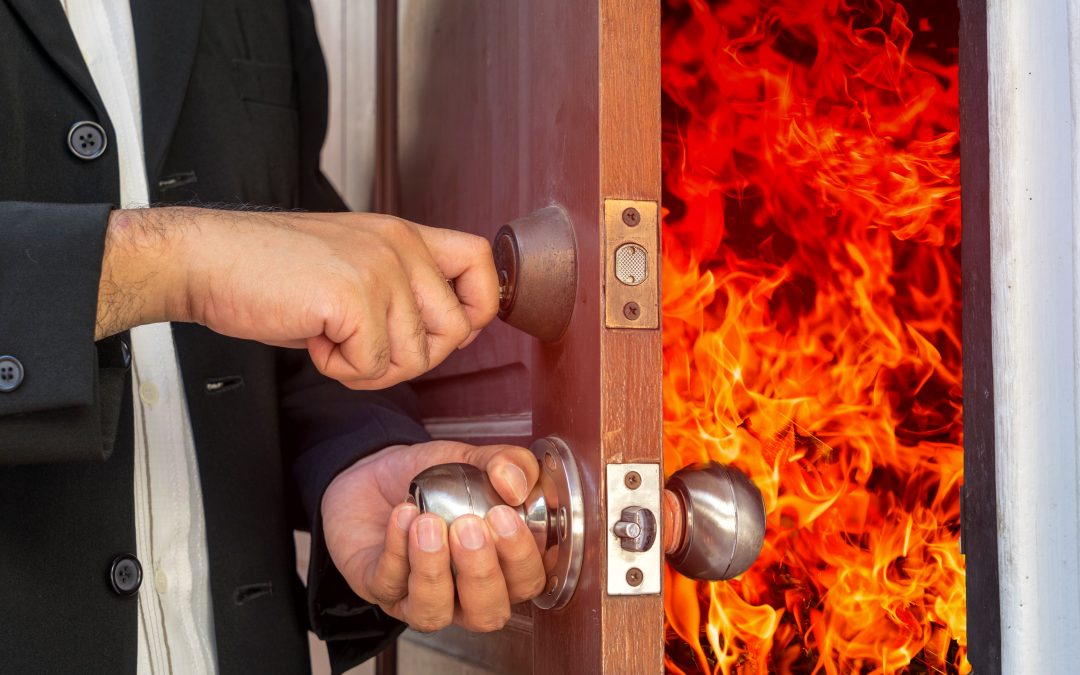When our assessors visit site, they are inevitably confronted with this issue. As you walk around any building look at the number of doors with the lovely blue sign “Fire Door Keep Shut” but which doors really need to have that sign?
Well, the simple answer is, “when it’s protecting an escape route or a room containing special hazards and/or risks.” but even that depends…
Fire doors have at least one of two functions. They protect escape routes so that occupants can get out of a building safely or to protect occupants, fire-fighters and the structure of a building by limiting the spread of fire.
However, whether a door needs to be a fire door will depend on a number of factors including the fire strategy employed by the owners, insurance requirements and of course the applicable legislation.
For the purposes of Life Safety, as a minimum, you must protect your means of escape and any rooms containing special risks or hazards.
This means you are not necessarily required to provide Fire Doors in other areas unless you choose to do so for Business and/or Property Protection purposes..
The Fire Safety Order 2005 placed a legal requirement on all workplaces to carry out fire risk assessments, and now the Fire Safety Act 2021 imposes the same duty on all domestic buildings containing two or more dwellings. But these assessments are focussed on Life Safety and NOT Property Protection.
This can often pose a dilemma for our customers as we often find Fire Doors have been installed for Property Protection purposes and during the lifetime of the building they inevitably become worn or damaged. But in many cases the law doesn’t required them to be replaced with another fire door.
For many organisations, replacing these doors could mean spending thousands of pounds and in the case of large organisations with many buildings, hundreds of thousands of pounds, perhaps unnecessarily.
Fire doors are a vital part of a building’s fire safety and can be very expensive. They need to be regularly assessed and are governed by a set of standards, and can also be expensive to maintain.
Only recently, one of our Assessors attended a property because the customer was concerned about the state of many of the Fire Doors. However, during the Fire Risk Assessment, our assessor deemed that for Life Safety, only 3 of 20 fire doors in the building were actually required to be Fire Doors.
Many of the other doors were in poor condition and several had holes or had been damaged and our customer was initially concerned that we did not recommend these doors be replaced. When we explained they were not required and could in effect either be replaced by standard doors or even removed altogether, the mood shifted.
Imagine the money wasted on over prescribed Fire Doors. The customer was facing a bill of many thousands of pounds but now had an expert’s advice and a rationale on why spending that money was not necessary.
How many Fire Doors do you have in your estate that do not need to be classed as Fire Doors?
How much of your maintenance budget is being swallowed unnecessarily?
What always sets alarm bells ringing for us, when we ask, “Who recommended all these fire doors need changing?”, we all too often hear, “Our fire door maintenance company”, no surprise there!
Always get an impartial assessment completed to give you the right advice. An impartial expert will simply tell you what you need to be compliant.
And be wary of anyone offering cheap Fire Risk Assessments who just happen to sell FFE, sprinklers, alarms, and Fire Doors, you will inevitably find they are writing their own shopping list that you will end up paying for.
To be clear, installing fire doors is cheaper than having to rebuild and if you can afford to put fire doors everywhere go ahead… we’re not saying you shouldn’t install fire doors everywhere, we’re saying you are not compelled to do so by law.
Riskmonitor is impartial and has over 20 years experience in ensuring our customers are compliant.
We are here to help, so let us help you, call us or email us at advice@riskmonitor.net


Recent Comments